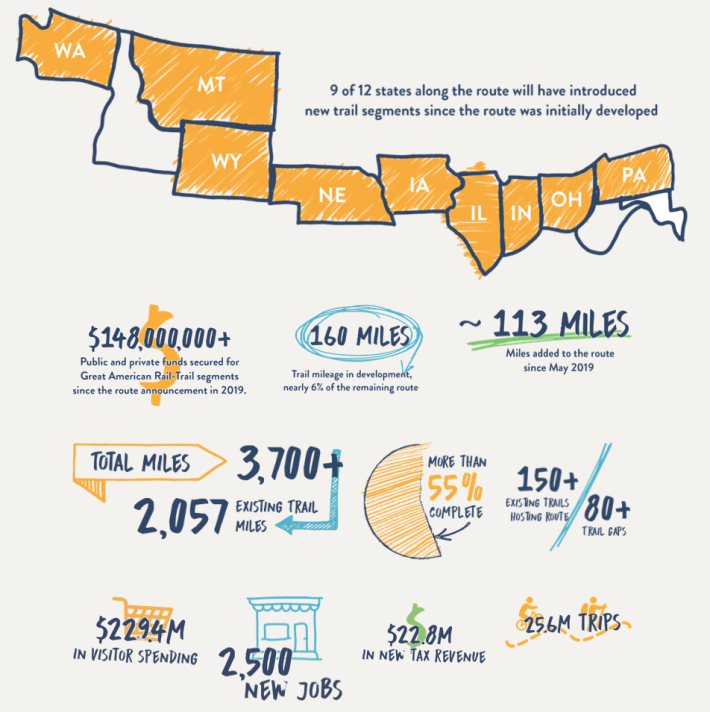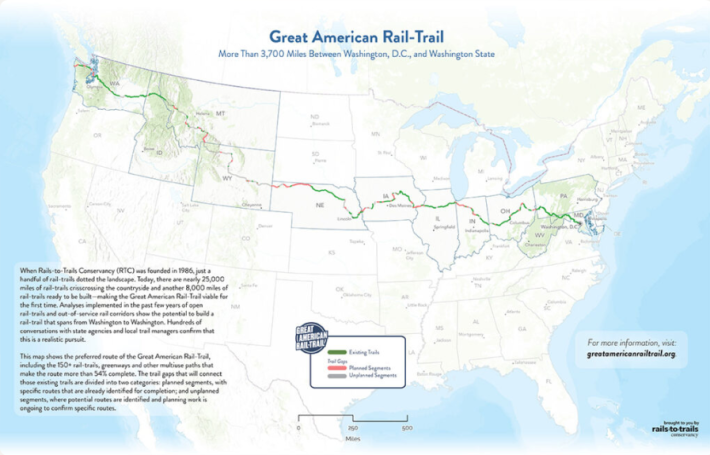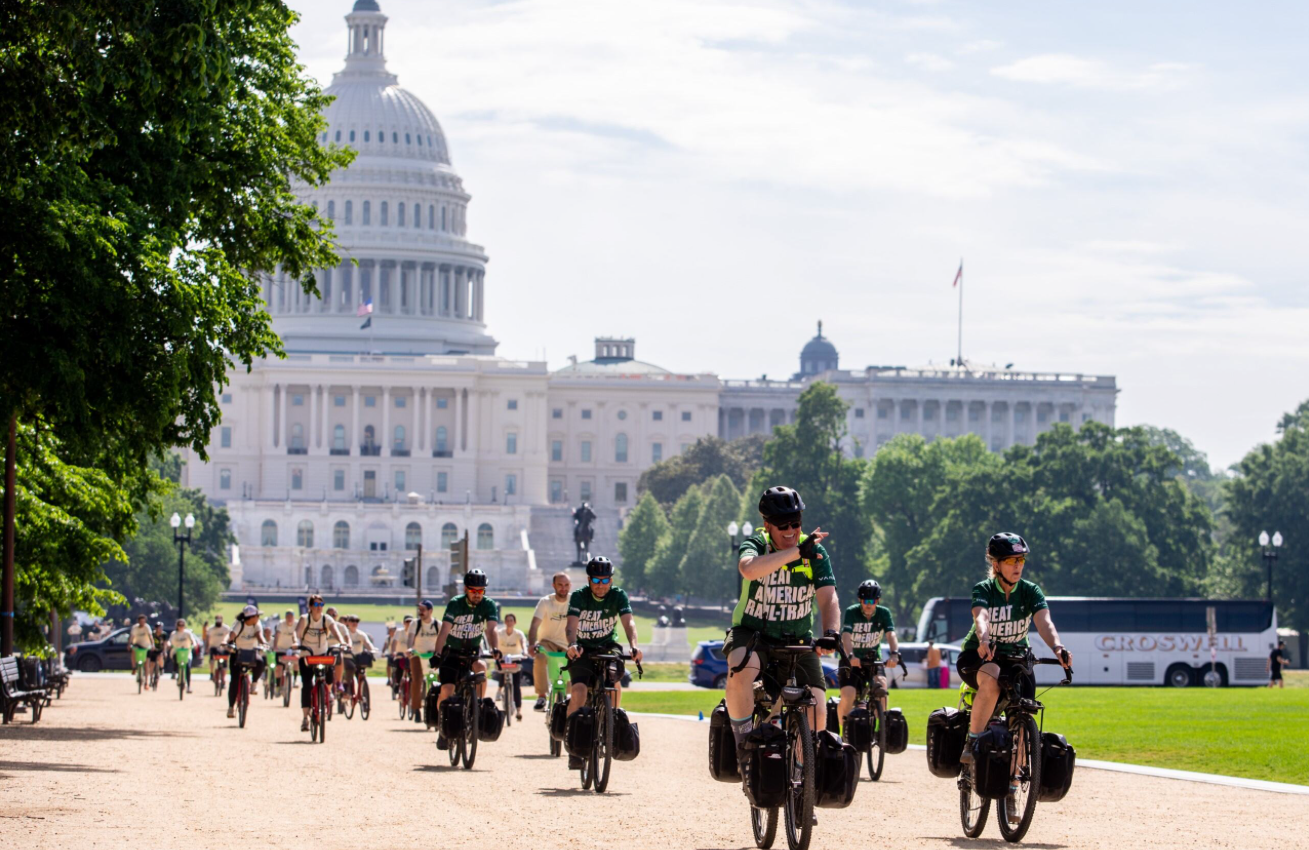A group of veterans is cycling on trails across America to help unravel the traumatic experiences of war — and to urge Congress to fund a program that will bring this powerful infrastructure to every U.S. resident.
Last week, a coalition of sustainable transportation advocates and outdoor enthusiasts gathered to send off seven military veterans on a more than 3,700-mile bike-packing tour of the Great American Rail Trail, which links communities from Washington, D.C. to Washington state through a network of safe, off-road routes made up of retired railway corridors, many of which weave seamlessly into local networks of biking and walking paths.

The trip, which is organized by nonprofit Warrior Expeditions, hopes to give the former Army and Air Force troops the space and time to unpack the impact of war while creating deep bonds with one another and the millions of Americans whose communities they’ll ride through.
For founder Sean Gobin, though, it’s also become about highlighting the power of the trail itself as a tool for processing trauma — something that wasn’t always available to veterans on previous Warrior Expeditions, which were primarily routed on conventional roads.
“The feedback we were getting from veterans was, ‘It was great, except for the traffic,’” Gobin says. “You can’t enjoy the serenity of nature and take in this experience when you’re out there dodging cars. I was desperately looking for a new route to use. … To be on paths specific to bike and foot traffic, where you don’t have to worry about drivers — that’s kind of the magic recipe. And we weren’t getting that traversing highways.”
While the Great American Rail Trail will give the riders thousands of miles of blissfully uninterrupted pedaling, it isn’t totally car-free just yet. Though the Rails to Trails Conservancy has successfully strung together over 130 different trail segments across 12 states in the five years since the route was announced, some stretches remain unfunded, forcing riders to detour onto public roads for a little less than half of the total mileage. That’s not only a problem for cyclists like the veterans who are pedaling for mental health and recreation, but for the countless people who rely on trails for transportation within and between their communities.
“The idea of the Great American Trail inspires people, I think because [it communicates] the idea the whole country can be woven together. But I think where it really touches the most people's lives is the connectivity it provides all along the way,” said Kevin Mills, vice president of Policy for the Rails to Trails Conservancy. “[This trail] is linking cities and suburbs and rural areas and small towns. The political divide in our country often breaks down between rural and urban; this [issue] speaks to the importance of active transportation across all those political divides.”

Mills says many of the gaps in the Great American Rail Trail could be filled by the federal Active Transportation Infrastructure Investment Program, which Congress authorized to provide up to $200 million to complete trail networks under the Bipartisan Infrastructure Law. So far, though, legislators have only appropriated $45 million to the program, even as the first round of applications for the money have overwhelmed administrators with the demand.
That’s in part because many communities have recognized that active transportation program funding can do double duty as transportation dollars, since 30 percent of the funding is required to be spent on completing in-town networks, with a further 30 percent reserved for building trail “spines” that link towns to one another.
“We're really trying to gather the chorus to say, ‘Now is the time to fully appropriate for this program, because we've yet to get the full $200 million a year that the authorization calls for,’” added Mills.
Gobin thinks advocates for mental health should be among the leading voices of that chorus. The veterans who’ve taken his expeditions have reported remarkable psychological benefits, in part because low-stress physical activity like a long bike ride can mimic the kinds of marches soldiers historically took home from the battlefront — offering them a critical opportunity to integrate difficult experiences that modern soldiers don’t typically get when they’re whisked away from war zones on planes. He emphasizes, though, that even those who have never served can experience similar benefits — and that trails can even “restore your faith in humanity” if you’re open to the personal connections they can cultivate.
“Obviously this ride will benefit our veterans, but trauma is an equal opportunity employer,” he added. “A lot of people are struggling with a lot of different issues. These trails are so important to people from all walks of life; it’s a huge benefit across the cultural divide.”

Experts say well-connected trail networks can also help minimize one of the most common yet overlooked sources of trauma in American life: a violent, car-dominated transportation system that leaves many with little access to mobility alternatives. A new survey of more than 3,000 cyclists from REI and People for Bikes found that only 58 percent bike for transportation, but 68 percent would do so more if there were dedicated bike lanes, paths or trails in their communities.
Mills argues that projects like the Great American Rail Trail can meet that need — and it’s time to put federal money behind it, especially in the low-income communities with the greatest gaps in their networks.
“In a previous generation, we connected our communities with roads,” Mills added. “Now it's time to do that for a walkable and bikable America.”
To send a message to your representatives urging them to fully fund the Active Transportation Infrastructure Investment Program, click here.






